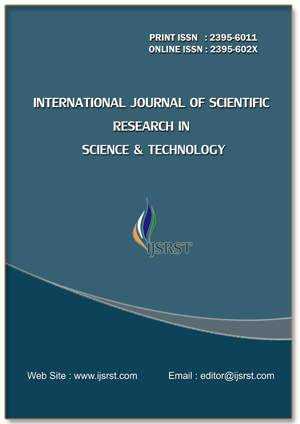Smart Ultrasonic Glasses for Blind People using Piezoelectric Sensors
DOI:
https://doi.org/10.32628/IJSRST251222623Keywords:
Visually impaired assistive technology, Wearable electronic travel aids (ETAs), Self-powered wearable devices, PVDF-based piezoelectric sensors, Biomechanical energy harvesting, Human motion energy conversionAbstract
Assistive Technology refers to devices that allow people with disabilities to maintain or increase their basic function capabilities. For people with visual impairment, there has been remarkable development in the field of assistive tech- nology, the emergence of wearable devices paving the way for development of Electronic Travel Aids(ETAs) that are used for obstacle detection and navigation.[2] These travel aids rely upon Camera-based systems and Ultrasonic sensors in order to provide guidance but these components require continuous power that limits their usability. This study aims to explore the addition of Piezoelectric sensors as a power source that is renewable, making the Smart ultrasonic glasses self-sustaining, without requiring frequent charging. A systematic review of existing research work that has contributed to the current technology and recent developments has been conducted[5]. The findings indicate that by utilizing Piezoelectric Nanogenerators (PENGs) and Zigzag- structured PVDF- harvesters, the energy generated by the bodily motions of humans (the energy that generally goes waste or gets released in form of heat to environment) can be converted into an ideal power source. Although, there are several challenges such as energy storage limitation, environmental dependencies, and the most important one Low Power Output that needs to be addressed before real world deployment of any such technology[7]. This study aims to propose a possible and viable solution for development of Energy-efficient glasses for visually impaired individuals.
📊 Article Downloads
References
Bagla, A., Hembram, K., Rault, F., Salau¨n, F., Sundarrajan, S., Ramakr- ishna, S., & Mitra, S. 2025. The Journal of Physical Chemistry C. ZnO@ C/PVDF Electrospun Membrane as a Piezoelectric Nanogenerator for Wearable Applications.
Ali, A., Iqbal, S., & Chen, X. 2024. Energy Strategy Reviews. Recent advances in piezoelectric wearable energy harvesting based on human motion: Materials, design, and applications. 53, 101422.
Bairagi, S., Shahadat, M., Mulvihill, D. M., & Ali, W. 2023. Nano Energy. Mechanical energy harvesting and self-powered electronic applications of textile-based piezoelectric nanogenerators: A systematic review. 111, 108414.
Qian, S., Wang, X., & Yan, W. 2023. Frontiers of Optoelectronics. Piezoelectric fibers for flexible and wearable electronics. 16(1), 3.
Pattipaka, S., Bae, Y. M., Jeong, C. K., Park, K. I., & Hwang, G. T. 2022. Sensors. Perovskite piezoelectric-based flexible energy harvesters for self-powered implantable and wearable IoT devices. 22(23), 9506.
Xu, P., Kennedy, G. A., Zhao, F. Y., Zhang, W. J., & Van Schyndel, R. 2023. IEEE Access. Wearable obstacle avoidance electronic travel aids for blind and visually impaired individuals: A systematic review. 11, 66587–66613.
Khan, S., Nazir, S., & Khan, H. U. 2021. IEEE Access. Analysis of navigation assistants for blind and visually impaired people: A systematic review. 9, 26712–26734.
Mokhtari, F., Shamshirsaz, M., Latifi, M., & Foroughi, J. 2020. Poly- mers. Nanofibers-based piezoelectric energy harvester for self-powered wearable technologies. 12(11), 2697.
Zhou, Z., Padgett, S., Cai, Z., Conta, G., Wu, Y., He, Q., ... & Chen, J. 2020. Biosensors and Bioelectronics. Single-layered ultra-soft washable smart textiles for all-around ballistocardiograph, respiration, and posture monitoring during sleep. 155, 112064.
Cao, W., Yu, W., & Huang, W. 2019. Artificial Intelligence on Fash- ion and Textiles: Proceedings of the Artificial Intelligence on Fashion and Textiles (AIFT) Conference 2018, Hong Kong, July 3–6, 2018. A Piezoelectric Energy Harvester for Wearable Applications. Springer International Publishing. pp. 61–67.
Liu, Y., Pharr, M., & Salvatore, G. A. 2017. ACS Nano. Lab-on- skin: a review of flexible and stretchable electronics for wearable health monitoring. 11(10), 9614–9635.
Zheng, Q., Zhang, H., Shi, B., Xue, X., Liu, Z., Jin, Y., ... & Wang, Z. L. 2016. ACS Nano. In vivo self-powered wireless cardiac monitoring via implantable triboelectric nanogenerator. 10(7), 6510–6518.
Yao, S., & Zhu, Y. 2015. Advanced Materials. Nanomaterial- enabled stretchable conductors: strategies, materials and devices. 27(9), 1480–1511.
Hu, Y., & Wang, Z. L. 2015. Nano Energy. Recent progress in piezoelectric nanogenerators as a sustainable power source in self-powered systems and active sensors. 14, 3–14.
Ali, A., Shaukat, H., Bibi, S., Altabey, W. A., Noori, M., & Kouritem, S. A. 2023. Energy Strategy Reviews. Recent progress in energy harvesting systems for wearable technology. 49, 101124.
Shaukat, H., Ali, A., Bibi, S., Altabey, W. A., Noori, M., & Kouritem, S. A. 2023. Applied Sciences. A Review of the recent advances in piezoelectric materials, energy harvester structures, and their applications in analytical chemistry. 13(3), 1300.
Mokhtari, F., et al. 2023. Global Challenges. Advances in wearable piezoelectric sensors for hazardous workplace environments. 7(6), 2300019.
Dong, H., et al. 2024. JOM. Piezoelectric composites: state-of-the-art and future prospects. 76(1), 340–352.
Qian, S., Wang, X., & Yan, W. 2023. Frontiers of Optoelectronics. Piezoelectric fibers for flexible and wearable electronics. 16(1), 3.
Ali, I., et al. 2024. Small Structures. 2D material‐based wearable energy harvesting textiles: a review. 5(1), 2300282.
Piezo Direct. 2024. Understanding Unimorphs: A Deep Dive into Piezoelectric Technology. Retrieved from https://piezodirect.com/understanding-unimorphs-a-deep-dive-into-piezoelectric-technology.
IEEE International Ultrasonics Symposium. 2020. Piezoelectrics for Wearable Applications – Invited Speaker Presentation. Retrieved from https://2020.ieee-ius.org/presentation/invited-speaker/piezoelectrics-wearable-applications.
Rehman, A. U., Babar, M. J., & Kim, W. 2023. Materials Circular Economy. Recent advances in piezoelectric nanogenerators for self-powered wearable applications: materials, structures, and performance. https://link.springer.com/article/10.1007/s42791-023-00053-x.
Pan, C.-T., Chou, M.-Y., & Huang, J.-C. 2023. Encyclopedia of Smart Materials. Piezoelectric Energy Harvesting Systems for Wearable Devices. https://link.springer.com/referenceworkentry/10.1007/978-3-030-97940-9_190.
A. Ali, S. Iqbal, and X. Chen, “Recent advances in piezoelectric wearable energy harvesting based on human motion: Materials, design, and applications,” Energy Strategy Reviews, vol. 53, p. 101422, 2024, doi: 10.1016/j.esr.2024.101422.
Dr. Jabir Ali _ Bannet University, Greater _ Noida_jabir.ali@bennett.edu.in.
Dr. Abha Kiran Rajpoot _ Galgotias University, Greater Noida _ abha.rajpoot@galgotiasuniversity.edu.in
Dr. Vijay Shukla _ Greater Noida Institute of Engineering and Technology, Greater Noida _ drvijayshukla.cse@gniot.net.in
Downloads
Published
Issue
Section
License
Copyright (c) 2025 International Journal of Scientific Research in Science and Technology

This work is licensed under a Creative Commons Attribution 4.0 International License.
https://creativecommons.org/licenses/by/4.0




